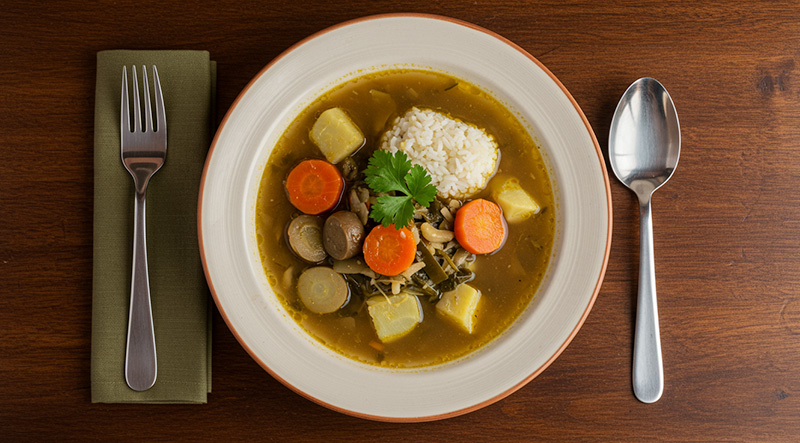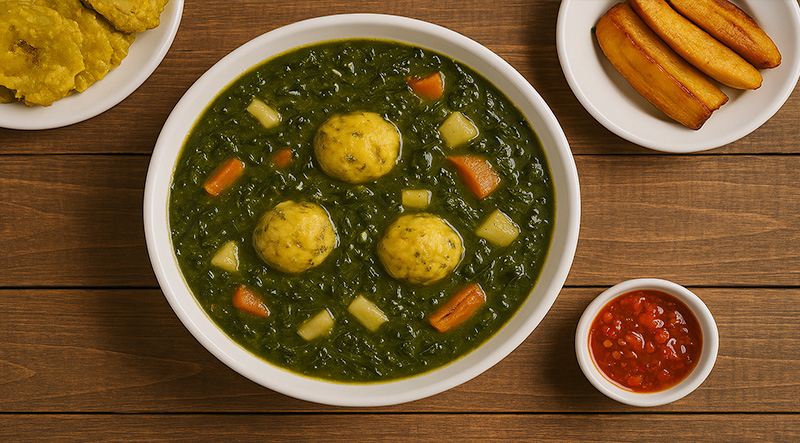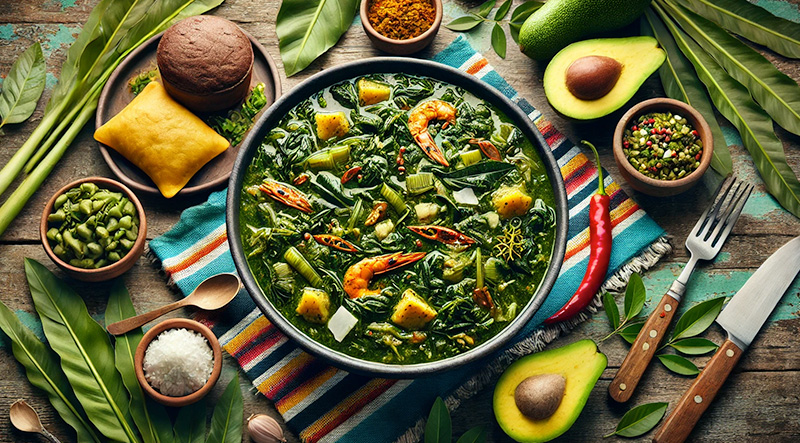Dive into the vibrant flavors of Dominica with Callaloo Soup, a rich and hearty dish that’s as green as the island’s lush rainforest and just as soul-satisfying. Made from tender dasheen leaves (or spinach as a substitute), simmered with coconut milk, pumpkin, dumplings, and often flavored with salted meat or sausage, this velvety soup is a true Caribbean comfort food. With every spoonful, Callaloo Soup warms the heart and celebrates Dominica’s deep-rooted love for fresh, earthy ingredients and bold island taste. Read More...
Callaloo Soup- The Heart and Heritage of Dominica in a Bowl:
Callaloo Soup, the national dish of Dominica, is more than a delicious bowl of greens and spices—it’s a living story of the island’s agricultural soul, colonial past, African heritage, and deep connection to the land. Rich, creamy, and full of local ingredients, this soup has evolved into a culinary symbol of Dominican identity, proudly served in homes and restaurants across the “Nature Island” of the Caribbean.
A Rooted Beginning – African and Indigenous Influence:
The history of Callaloo Soup in Dominica can be traced back to the island’s African roots and the agricultural knowledge of its indigenous Kalinago people. The term “callaloo” itself is derived from West Africa, where similar leafy green dishes were traditionally prepared using amaranth or other local greens. Enslaved Africans brought to the Caribbean adapted the dish to the ingredients available in the region—most notably, the large, heart-shaped leaves of the dasheen plant (also known as taro).
These leaves, when cooked, yield a soft, spinach-like texture and earthy flavor that form the foundation of the soup. Over time, Dominicans enriched this dish with elements like coconut milk, pumpkin, okra, green bananas, and salted meats, adding depth and richness to the humble greens.
A Reflection of the Land:
Dominica’s nickname, The Nature Island, is perfectly embodied in Callaloo Soup. The dish is a reflection of the island’s verdant hillsides, fertile valleys, and self-sustaining farming practices. Nearly all of the ingredients used in Callaloo Soup—dasheen leaves, pumpkin, coconut, herbs, and spices—are grown locally. This makes the soup not only a delicious staple but also a sustainable one, connecting Dominicans directly to their land.
The inclusion of starchy dumplings (locally known as “droppers” or “domplin”) and provisions like green bananas and breadfruit further showcases the island’s bounty. When prepared with smoked or salted meats such as pig tail or crab, the dish takes on a festive, coastal flair often enjoyed during holidays or large family gatherings.
A Dish of Unity and Comfort:
Throughout Dominica’s colonial era under both French and British rule, local cuisine remained a powerful expression of cultural identity. Callaloo Soup stood out as a nourishing dish that crossed social and economic lines—it was easy to prepare, affordable, and endlessly adaptable depending on what was available. It became a go-to comfort food, a healing soup during illness, and a proud feature at celebrations.
Today, Callaloo Soup is often served at Sunday lunch or as a starter for special events. It’s a dish that unites generations, often made with passed-down techniques and seasoned “just right” with thyme, scotch bonnet pepper, and a touch of love.
Recognition as a National Symbol:
Although Dominica has a wide array of traditional dishes, Callaloo Soup holds a special place as the country’s national dish. It was officially recognized for its representation of Dominican heritage, agricultural abundance, and the blending of indigenous and African culinary roots. It also stands apart from similar soups in neighboring islands through its unique preparation and use of Dominican-grown ingredients.
A Taste of Tradition in Every Spoon:
Whether sipped from a bowl at a roadside stand or savored at a family table overlooking Dominica’s rolling hills, Callaloo Soup continues to tell the story of a resilient people and a fertile land. It’s a dish steeped in history, flavored by culture, and warmed by community spirit. One taste is all it takes to understand why this green, creamy, spice-kissed soup is the pride of Dominica.
Prep the Dumplings (optional):
Season & Parboil the Salted Meats (if using):
Build the Flavor Base:
Combine Liquids & Greens:
Add Callaloo Leaves:
Simmer & Season:
Finish with Dumplings:

Blend for Creaminess (optional but traditional):

Serve Hot:

Cook’s Notes:
A bowl of Callaloo Soup delivers Dominica’s rainforest freshness in every spoonful—hearty, velvety, and boldly Caribbean. Bon appétit!
The total preparation and cooking time for Callaloo Soup is approximately 1 hour and 15 minutes. Preparing the ingredients—including cleaning and chopping the dasheen leaves, dicing vegetables, soaking and parboiling salted meats (if used), and mixing dumpling dough—takes about 25–30 minutes. Cooking the soup involves building the flavor base, simmering the broth with meats and provisions, adding the greens, and optionally blending for texture, which takes an additional 40–45 minutes. With good kitchen flow, the dish can be completed from start to finish in just over an hour, making it a relatively quick yet nourishing meal full of Dominican flavor.
A single serving of Callaloo Soup, based on the recipe provided, contains approximately **300 to 400 calories**, depending on the ingredients and portions used. The base of dasheen leaves (or spinach), pumpkin, and coconut milk contributes a nutrient-dense but moderate calorie count, with about 100–150 calories from vegetables and greens, and another 100–150 calories from the coconut milk alone. If salted meats or crab are included, they can add an additional 50–100 calories per serving, while dumplings and root vegetables (provisions) may add around 50–80 calories more. Overall, it’s a wholesome, filling soup rich in fiber, iron, and healthy fats, yet relatively low in total calories.







